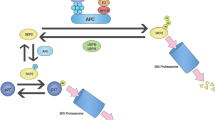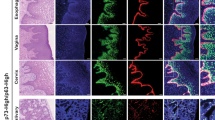Abstract
Skp2 is an F-box protein involved in the ubiquitination and subsequent degradation of the cyclin-dependent kinase (Cdk) inhibitor p27. Skp2 has been reported to be overexpressed in a variety of cancer types and to correlate with poor prognosis. We have identified a novel isoform of Skp2 we named Skp2B, which differs from Skp2 only in the C-terminal domain and unlike Skp2 localizes to the cytoplasm. Here, we describe the relative expression of both Skp2 and Skp2B in breast cancer cell lines and in primary breast cancers using quantitative real time RT–PCR. We show that Skp2B mRNA is expressed 10-fold less than Skp2 mRNA in the immortalized but non-transformed breast cell line, 184B5. However, Skp2B is overexpressed as frequently as Skp2, and to higher levels than Skp2 in breast cancer cell lines and primary cancers. Further, we show that cytoplasmic staining is frequent in primary breast cancers. In addition, we found that xenografts expressing Skp2B grow faster than xenografts expressing low levels of Skp2B, and that this effect is independent of p27 degradation. These findings therefore suggest that Skp2B overexpression is also observed in breast cancers and identify Skp2B as a putative oncogene.
This is a preview of subscription content, access via your institution
Access options
Subscribe to this journal
Receive 50 print issues and online access
$259.00 per year
only $5.18 per issue
Buy this article
- Purchase on Springer Link
- Instant access to full article PDF
Prices may be subject to local taxes which are calculated during checkout








Similar content being viewed by others
References
Bai C, Sen P, Hofmann K, Ma L, Goebl M, Harper JW and Elledge SJ . (1996). Cell, 86, 263–274.
Carrano AC, Eytan E, Hershko A and Pagano M . (1999). Nat. Cell Biol., 1, 193–199.
Dowen SE, Scott A, Mukherjee G and Stanley MA . (2003). Int. J. Cancer, 105, 326–330.
Drobnjak M, Melamed J, Taneja S, Melzer K, Wieczorek R, Levinson B, Zeleniuch-Jacquotte A, Polsky D, Ferrara J, Perez-Soler R, Cordon-Cardo C, Pagano M and Osman I . (2003). Clin. Cancer Res., 9, 2613–2619.
Feldman RM, Correll CC, Kaplan KB and Deshaies RJ . (1997). Cell, 91, 221–230.
Ganiatsas S, Dow R, Thompson A, Schulman B and Germain D . (2001). Oncogene, 20, 3641–3650.
Gstaiger M, Jordan R, Lim M, Catzavelos C, Mestan J, Slingerland J and Krek W . (2001). Proc. Natl. Acad. Sci. USA, 98, 5043–5048.
Harper JW . (2001). Curr. Biol., 11, R431–R435.
Inui N, Kitagawa K, Miwa S, Hattori T, Chida K, Nakamura H and Kitagawa M . (2003). Biochem. Biophys. Res. Commun., 303, 978–984.
Joazeiro CA and Weissman AM . (2000). Cell, 102, 549–552.
Kipreos ET, Lander LE and Wing JP . (1996). Cell, 85, 829–839.
Krek W . (1998). Curr. Opin. Genet. Dev., 8, 36–42.
Loda M, Cukor B, Tam SW, Lavin P, Fiorentino M, Draetta GF, Jessup JM and Pagano M . (1997). Nat. Med., 3, 231–234.
Masuda TA, Inoue H, Nishida K, Sonoda H, Yoshikawa Y, Kakeji Y, Utsunomiya T and Mori M . (2003). Clin. Cancer Res., 9, 5693–5698.
Ohta T, Michel JJ, Schottelius AJ and Xiong Y . (1999). Mol. Cell, 3, 535–541.
Patton EE, Willems AR and Tyers M . (1998). Trends Genet., 14, 236–243.
Penin RM, Fernandez-Figueras MT, Puig L, Rex J, Ferrandiz C and Ariza A . (2002). Mod. Pathol., 15, 1227–1235.
Schulman BA, Carrano AC, Jeffrey PD, Bowen Z, Kinnucan ER, Finnin MS, Elledge SJ, Harper JW, Pagano M and Pavletich NP . (2000). Nature, 408, 381–386.
Shapira M, Ben-Izhak O, Bishara B, Futerman B, Minkov I, Krausz MM, Pagano M and Hershko DD . (2004). Cancer, 100, 1615–1621.
Signoretti S, Di Marcotullio L, Richardson A, Ramaswamy S, Isaac B, Rue M, Monti F, Loda M and Pagano M . (2002). J. Clin. Invest., 110, 633–641.
Skowyra D, Craig KL, Tyers M, Elledge SJ and Harper JW . (1997). Cell, 91, 209–219.
Skowyra D, Koepp D, Kamura T, Conrad M, Conaway R, Conaway JW, Elledge S and Harper JW . (1999). Science, 284, 662–665.
Sutterluty H, Chatelain E, Marti A, Wirbelauer C, Senften M, Muller U and Krek W . (1999). Nat. Cell Biol., 1, 207–214.
Zhou P and Howley PM . (1998). Mol. Cell, 2, 571–580.
Acknowledgements
We thank Dr Matthew O'Connell for critical reading of this manuscript, Dr Melanie Connell for her professional advice on quantitative real time RT–PCR and Dr John Mandeli for statistical analysis of our data. We would also like to thank Rosie Monardo for technical assistance. This work was supported by the Samuel Waxman Cancer Research Foundation.
Author information
Authors and Affiliations
Corresponding author
Rights and permissions
About this article
Cite this article
Radke, S., Pirkmaier, A. & Germain, D. Differential expression of the F-box proteins Skp2 and Skp2B in breast cancer. Oncogene 24, 3448–3458 (2005). https://doi.org/10.1038/sj.onc.1208328
Received:
Revised:
Accepted:
Published:
Issue Date:
DOI: https://doi.org/10.1038/sj.onc.1208328
Keywords
This article is cited by
-
Quadruple negative breast cancer
Breast Cancer (2020)
-
SKP2 promotes breast cancer tumorigenesis and radiation tolerance through PDCD4 ubiquitination
Journal of Experimental & Clinical Cancer Research (2019)
-
microRNA-186 inhibits cell proliferation and induces apoptosis in human esophageal squamous cell carcinoma by targeting SKP2
Laboratory Investigation (2016)
-
Drugging the undruggables: exploring the ubiquitin system for drug development
Cell Research (2016)
-
BRCA1 inhibits AR–mediated proliferation of breast cancer cells through the activation of SIRT1
Scientific Reports (2016)



